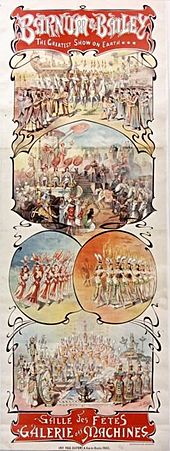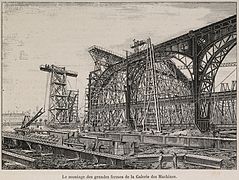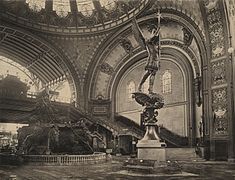
The Exposition Universelle of 1855, better known in English as the 1855 Paris Exposition, was a world's fair held on the Champs-Élysées in Paris, France, from 15 May to 15 November 1855. Its full official title was the Exposition Universelle des produits de l'Agriculture, de l'Industrie et des Beaux-Arts de Paris 1855. It was the first of ten major expositions held in the city between 1855 and 1937. Nowadays, the exposition's sole physical remnant is the Théâtre du Rond-Point des Champs-Élysées, designed by architect Gabriel Davioud, which originally housed the Panorama National.

The Exposition Universelle of 1900, better known in English as the 1900 Paris Exposition, was a world's fair held in Paris, France, from 14 April to 12 November 1900, to celebrate the achievements of the past century and to accelerate development into the next. It was the sixth of ten major expositions held in the city between 1855 and 1937. It was held at the esplanade of Les Invalides, the Champ de Mars, the Trocadéro and at the banks of the Seine between them, with an additional section in the Bois de Vincennes, and it was visited by more than fifty million people. Many international congresses and other events were held within the framework of the exposition, including the 1900 Summer Olympics.

The Exposition Universelle of 1878, better known in English as the 1878 Paris Exposition, was a world's fair held in Paris, France, from 1 May to 10 November 1878, to celebrate the recovery of France after the 1870–71 Franco-Prussian War. It was the third of ten major expositions held in the city between 1855 and 1937.

The Exposition Universelle of 1889, better known in English as the 1889 Paris Exposition, was a world's fair held in Paris, France, from 5 May to 31 October 1889. It was the fifth of ten major expositions held in the city between 1855 and 1937. It attracted more than thirty-two million visitors. The most famous structure created for the exposition, and still remaining, is the Eiffel Tower.

Champ de Mars–Tour Eiffel station is a station on RER C in Paris named for the nearby Champ de Mars and Eiffel Tower.

The Exposition universelle, internationale et coloniale was a world's fair including a colonial exhibition held at Parc de la Tête d'or in Lyon, France in 1894. The exposition drew unwanted attention with the assassination of French President Sadi Carnot during his visit on 24 June 1894; he died the day after. The exposition drew 3.8 million visitors.

The Vel' d'Hiv' Roundup was a mass arrest of Jewish families by French police and gendarmes at the behest of the German authorities, that took place in Paris on 16–17 July 1942. The roundup was one of several aimed at eradicating the Jewish population in France, both in the occupied zone and in the free zone that took place in 1942, as part of Opération Vent printanier. Planned by René Bousquet, Louis Darquier de Pellepoix, Theodor Dannecker and Helmut Knochen; It was the largest French deportation of Jews during the Holocaust.

The Vélodrome d'Hiver, colloquially Vel' d'Hiv', was an indoor bicycle racing cycle track and stadium (velodrome) on rue Nélaton, not far from the Eiffel Tower in Paris. As well as a cycling track, it was used for ice hockey, basketball, wrestling, boxing, roller-skating, circuses, bullfighting, spectaculars, and demonstrations. It was the first permanent indoor track in France and the name persisted for other indoor tracks built subsequently.

The Brussels International Exposition of 1935 was a world's fair held between 27 April and 6 November 1935 on the Heysel/Heizel Plateau in Brussels, Belgium.

The Musée national des Monuments Français is today a museum of plaster casts of French monuments located in the Palais de Chaillot, 1, place du Trocadéro et du 11 Novembre, Paris, France. It now forms part of the Cité de l'Architecture et du Patrimoine, and is open daily except Tuesday. An admission fee is charged.
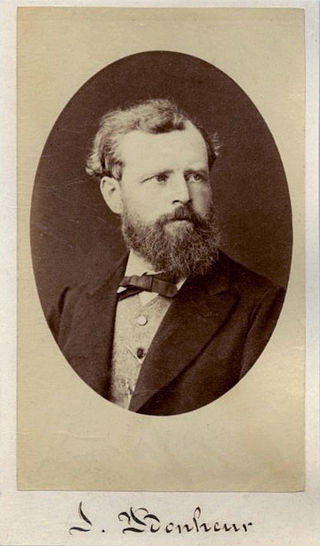
Isidore Jules Bonheur, best known as one of the 19th century's most distinguished French animalier sculptors. Bonheur began his career as an artist working with his elder sister Rosa Bonheur in the studio of their father, drawing instructor Raymond Bonheur. Initially working as a painter, Isidore Jules Bonheur made his Salon debut in 1848.
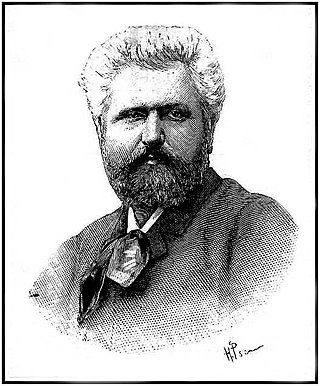
Charles Léon Stephen Sauvestre was a French architect. He is notable for being one of the architects contributing to the design of the world-famous Eiffel Tower, built for the 1889 Universal Exposition in Paris, France.

Eugène Alfred Hénard was a French architect and a highly influential urban planner. He was a pioneer of roundabouts, which were first introduced in Paris in 1907.
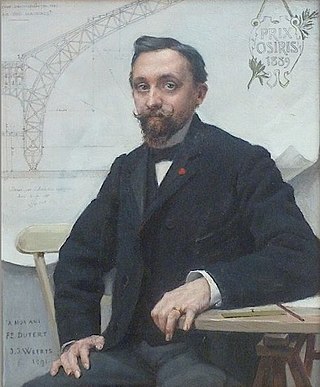
Charles Louis Ferdinand Dutert was a French architect.
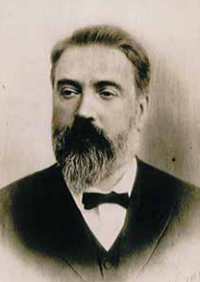
Victor Contamin (1840–1893) was a French structural engineer, an expert on the strength of materials such as iron and steel. He is known for the Galerie des machines of the Exposition Universelle (1889) in Paris. He also pioneered the use of reinforced concrete.
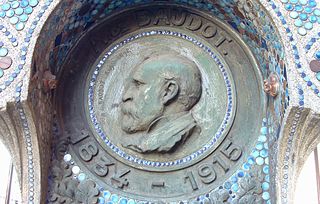
Joseph-Eugène-Anatole de Baudot was a French architect and a pioneer of reinforced-concrete construction. He was a prolific author, architect for diocesan buildings, architect for historical monuments, and a professor of architecture. He is known for the church of Saint-Jean-de-Montmartre in Paris, the first to be built using concrete reinforced with steel rods and wire mesh.

Charles Oudin is one of the oldest French horology firms. It was founded in Paris at the end of the 18th century by Jean-Charles Oudin, who came from a family of clockmakers in Northwest France. There were four generations of Oudins who were clockmakers, as of the mid 18th century, first in the Meuse region and later, in Paris. Several members of the Oudin family worked for the master watch and clockmaker Abraham-Louis Breguet.

The French Industrial Exposition of 1834 was the eighth in a series of eleven French national industrial expositions held to encourage improvements in progressive agriculture and in technology, that had their origins in 1798.

The Decauville railway at Exposition Universelle (1889) was a 3 km (1.9 mi) long 600 mm gauge railway line, which operated during the Exposition Universelle world fair from 6 May to 31 October 1889 from Esplanade des Invalides to Avenue de Suffren in Paris.

The Royal Pavilion of Spain was the exhibition national pavilion of the Kingdom of Spain at the 1900 Paris Universal Exposition. It was a temporary building by architect José Urioste Velada in Neo-Plateresque style located on the Quai d'Orsay. It housed a Retrospective Exhibition of Spanish Art, the Royal Office of the Spanish Commissioner at the Fair and the first restaurant in History with a completely electric kitchen.


